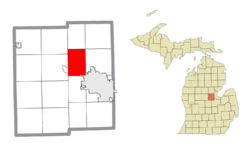Lincoln Township, Midland County, Michigan facts for kids
Quick facts for kids
Lincoln Township, Michigan
|
|
|---|---|

Location within Midland County and the state of Michigan
|
|
| Country | United States |
| State | Michigan |
| County | Midland |
| Area | |
| • Total | 23.4 sq mi (61 km2) |
| • Land | 23.3 sq mi (60 km2) |
| • Water | 0.1 sq mi (0.3 km2) |
| Elevation | 640 ft (195 m) |
| Population
(2020)
|
|
| • Total | 2,497 |
| • Density | 107.3/sq mi (41.4/km2) |
| Time zone | UTC-5 (Eastern (EST)) |
| • Summer (DST) | UTC-4 (EDT) |
| ZIP Codes | |
| Area code(s) | 989 |
| FIPS code | 26-111-47680 |
| GNIS feature ID | 1626623 |
Lincoln Township is a community located in Midland County in the U.S. state of Michigan. It's a type of local government area called a civil township. In 2020, the population of Lincoln Township was 2,497 people.
Contents
Exploring Averill: A Historic Community
Averill is a small, unincorporated community within Lincoln Township. It's located in the southern part of the township. This area started as a place for lumberjacks. There was even a famous saloon called "Red Keg." This saloon became well-known through novels written by Eugene Thwing.
A post office was set up here on September 30, 1868. It was first called "Averill's Station." This name came from the first postmaster, Averill S. Harrison. The name was later shortened to Averill on June 2, 1883. The community was officially mapped out, or platted, in 1870.
Geography of Lincoln Township
Lincoln Township is in the middle of Midland County. It shares its border with the city of Midland to the southeast. Midland is also the main city, or county seat, of the county. To the west, the township borders the village of Sanford.
Land and Water Areas
The township covers a total area of about 23.4 square miles (60.6 square kilometers). Most of this area, about 23.3 square miles (60.3 square kilometers), is land. A small part, about 0.1 square miles (0.3 square kilometers), is water. This means water makes up about 0.41% of the total area.
Rivers and Drainage
The township's land is drained by smaller streams and rivers. These streams flow into the Tittabawassee River. The Tittabawassee River itself crosses the southwest corner of Lincoln Township.
Population Changes Over Time
| Historical population | |||
|---|---|---|---|
| Census | Pop. | %± | |
| 1870 | 322 | — | |
| 1880 | 173 | −46.3% | |
| 1890 | 252 | 45.7% | |
| 1900 | 343 | 36.1% | |
| 1910 | 392 | 14.3% | |
| 1920 | 357 | −8.9% | |
| 1930 | 350 | −2.0% | |
| 1940 | 503 | 43.7% | |
| 1950 | 739 | 46.9% | |
| 1960 | 1,000 | 35.3% | |
| 1970 | 1,417 | 41.7% | |
| 1980 | 1,643 | 15.9% | |
| 1990 | 1,807 | 10.0% | |
| 2000 | 2,277 | 26.0% | |
| 2010 | 2,474 | 8.7% | |
| 2020 | 2,497 | 0.9% | |
| U.S. Decennial Census | |||
The population of Lincoln Township has changed a lot over the years. In 1870, only 322 people lived there. The population went up and down for a while. By 1940, it had grown to 503 people.
Since then, the number of people living in Lincoln Township has steadily increased. In 1960, the population reached 1,000. By the year 2000, there were 2,277 residents. The most recent count in 2020 showed a population of 2,497 people.
Community Life in 2000
In the year 2000, there were 2,277 people living in the township. There were 838 households, which are groups of people living together in one home. Out of these, 648 were families.
Many households, about 37%, had children under 18 living with them. Most households, about 67.1%, were married couples living together. The average household had about 2.72 people. The average family had about 3.07 people.
The population was spread out by age. About 28.1% of the people were under 18 years old. About 8% were 65 years or older. The median age, which is the middle age of all the people, was 36 years old.
See also
 In Spanish: Municipio de Lincoln (condado de Midland) para niños
In Spanish: Municipio de Lincoln (condado de Midland) para niños



